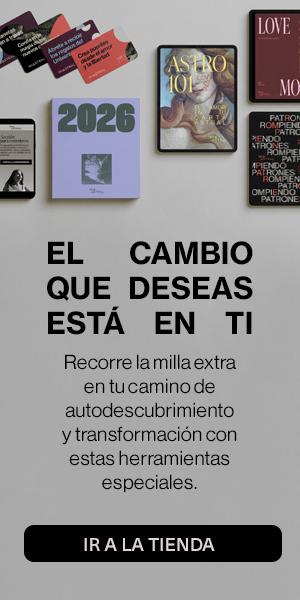
Entrevista a la food coach Dana James: descubre la raíz de los desórdenes alimenticios
¿Te gustó este contenido? Haz clic en me gusta y consulta de nuevo, cuando quieras, en la sección de Mis Favoritos
Tuve la oportunidad de realizarle una entrevista muy especial a Dana James, autora del libro “The archetype type” y nutricionista certificada en terapia de comportamiento. Ella es la mente detrás de Food Coach, una práctica de medicina nutricional que se enfoca en corregir balances bioquímicos y psicológicos a través de la intervención nutricional y la exploración psicológica. Aquí conversamos sobre el origen de los desórdenes alimenticios, su prevalencia en la actualidad y cuáles comportamientos son señal de que debemos buscar ayuda profesional para salir de ese patrón.
Al final de la entrevista encontrarán su versión original en inglés.
Los desórdenes alimenticios han existido desde siempre, pero, ¿se puede decir que ahora hay nuevos desórdenes alimenticios o desórdenes de imagen corporal?
No son las imágenes del cuerpo “perfecto” las que desencadenan un desorden alimenticio, de esa manera todas las mujeres que no entraran en ese molde tendrían un desorden alimenticio. Más bien el niño o joven tiene una experiencia personal que le hace sentir que no es “suficientemente bueno”. Así que usa la comida como una herramienta para lidiarlo. Se convierte en un arma de restricción o de comer en exceso. La experiencia negativa personal quizá no tiene nada que ver con su cuerpo. Por ejemplo, puede sentirse emocionalmente rechazado y creer que la forma de obtener atención es teniendo un cuerpo más atractivo. O quizás se restringe de comer para ser más “invisible”. No podemos decir que los desórdenes alimenticios son más prevalentes hoy debido a las redes sociales. Más bien, las redes nos dan una oportunidad de ver cuerpos femeninos diversos.
¿Cuán importante es crear consciencia sobre estos temas y la constante y directa publicidad del “cuerpo perfecto” en redes sociales?
Las mujeres en redes sociales constantemente se están tomando fotos de sus cuerpos esbeltos en lo que yo llamo arquetipo de femme fatale. Ponen la raíz de su valor en su apariencia física. Es un lugar muy incómodo para estar. Cuando veo a esas mujeres no veo un cuerpo “flaco”, veo el cuerpo que va pegado al dolor que causa mantener ese cuerpo. Para esas mujeres y otras “mujeres fatales”, la libertad solo vendrá de reconocer cuáles experiencias les han dicho que es su cuerpo lo que indica que son merecedoras de atención y de amor. El siguiente paso es interpretar esas memorias tan fallidas como sean y bajo el lente que fueron hechas, sea del niño o del adolescente. El paso final es liberar energéticamente el dolor apegado a esa memoria. Cubre esto como parte de la reprogramación mental “6-R” en mi libro “The Archetype Diet” (La dieta del arquetipo). Un punto importante es mostrar imágenes de mujeres con diferentes tallas y formas para aliviar el dolor de otras mujeres. Es un trabajo interno porque su psicología debe cambiar, aún así, es crucial que normalicemos todas las figuras y tallas. Hoy en día la mayoría de las mujeres tiene sobrepeso, es más común que un peso “normal”. Así como hemos visto que la homosexualidad ha sido públicamente aceptada, así hemos visto una mayor aceptación de la figura femenina que no se ve como una modelo delgada. Las mujeres están demandando que sus “tallas” no sean retocadas y esto es sumamente positivo.
¿Qué es el ED y, por favor, explícanos cómo se diferencia de las personas que pasan por períodos de ayuno de vez en cuando?
ED o desorden alimenticio proviene de la vergüenza. El comer en exceso no. Creo que el ED es mayormente mal diagnosticado porque la gente -erróneamente- asume que se trata de consumir masivamente comida (pizza, pasteles, helado y chocolate). No lo es, es simplemente comer hasta el punto de sentirte incómodo y sentirte mal todo el tiempo.
Por favor, explícanos la gravedad de la situación y la importancia de buscar ayuda.
Entre más repites un comportamiento de ED (Eating disorder o desorden alimenticio), sea restricción, comer en exceso para luego purgarte, o tener atracones, entre más se convierta en un hábito, el cerebro se cablea para asociar los gatillos con la respuesta del desorden. El comportamiento se imprime más en la persona. La vergüenza se vuelve peor. Ninguna mujer está orgullosa de su actividad de ED. Entre más vergüenza tienes es más probable caer en la depresión, ansiedad social o retraerse. Una vez que te retraes de tu entorno pierdes la herramienta más poderosa de sanación: la conexión. No puedo resaltar esto más: si te ves cayendo en uno de estos patrones, busca ayuda profesional con rapidez.
Lo he dicho un millón de veces: una persona puede creer que se puede recuperar sola de un desorden alimenticio, pero es casi imposible. ¿Cuándo crees que alguien debe buscar ayuda inmediatamente?
A menos que tengas una historia de trabajar con un terapeuta, es muy difícil, si no casi imposible entender las influencias de tu infancia y las creencias que fueron impuestas en ti desde la perspectiva de la familia, la cultura y la sociedad. Estas creencias forman tu comportamiento, incluyendo tu relación con la comida. Un buen terapeuta no solo te ayudará a entender esto, sino que te brindará habilidades para desarrollar en el día a día con estos factores estresantes. Curar un desorden alimenticio no es solo un cambio de comportamiento, es un cambio psicológico que involucra desenterrar tus pensamientos subconscientes, lo que llamamos “puntos ciegos”. Si eres ciega ante ellos, ¿cómo puedes resolverlos? Buscar ayuda es positivo, no significa que no puedas lidiar con la situación, significa que tienes la sabiduría para reconocer que hay algo en tu comportamiento que está “desalineado” con quien quieres ser.
Si una persona tiene demasiada vergüenza como para pedir ayuda, ¿qué le dirías?
Para citar a Freud: “las emociones no expresadas nunca mueren, se entierran vivas y salen después en formas más horrendas”. Esas formas más feas son los comportamientos relacionados a desórdenes alimenticios. Cuando traes la vergüenza a la superficie, comienza a disolverse. Cuando discutes lo que te hace sentir avergonzado desmantelas el falso poder de la vergüenza.
Cuando las personas tienen un desorden alimenticio, otras áreas de su vida se ven muy afectadas. ¿Cuál ñarea crees que se ve más afectada?
Las relaciones personales. Los comportamientos de desórdenes alimenticios son hechos en secreto. Algunas veces el desorden de cumplir con el comportamiento es tan adictivo que una persona no se compromete a una relación íntima porque eso no le permitiría tener la posibilidad de cumplir con este comportamiento disfuncional. Mantiene el secreto oculto de su compañero y este puede sentirlo. Hay una distancia que se da entre parejas. Además, cuando una mujer está tan preocupada sobre su cuerpo, raramente podrá estar presente sexualmente con su compañero. Está demasiado distraída con su cuerpo físico como para entregarse al erotismo del sexo. Su compañero puede sentirse sexualmente rechazado y esto puede convertirse en una serie de problemas en su relación.
¿Los desórdenes alimenticios pueden regresar?, ¿puede una persona curarse por completo en un punto?
Claro que pueden ser completamente sanados. Un desorden alimenticio es solo una estrategia para lidiar con algo. Sería erróneo decir que este desorden está curado si la persona ya no cae en su actividad, pero aún tiene una relación disfuncional con su cuerpo. Eso no es curarse. Eso es una intervención. La verdadera curación recae en soltar las memorias distorsionadas que dicen que solo eres “merecedora” según cómo te ves, cómo atiendes a otros o si eres exitosa.
Háblanos de comer “emocionalmente”, ¿cómo lo identificamos?
Hay dos formas de comer emocionalmente:
- Cuando reconoces una emoción como la ira o la tristeza y usas la comida para calmarla. El arquetipo que defino como “cuidadora” cae con frecuencia en esto.
- Cuando suprimes emociones y usas la comida como la forma de reprimirlas. Mi arquetipo de “mujer maravilla” suele hacer esto.
Así como con los atracones, muchas más mujeres caen en estos comportamientos de lo que la sociedad quiere aceptar.
Cuando identificamos y nos cachamos en un patrón, ¿cómo podemos detenerlo?
Debes enfrentar la raíz del mismo. La comida es simplemente una estrategia para lidiar con eso. ¿Cuáles pensamientos te llevan a comer de más, restringirte o tener un atracón de comida? Ve hacia donde la vergüenza se aloja y encontrarás la raíz. Irónicamente, usar la comida como herramienta para lidiar con la vergüenza, trae más vergüenza que lo que originalmente generaba esa emoción.
English Version
Eating disorders have existed since forever. But can you say that now days are new eating or image disorders?
It is not the images of the “perfect” body that trigger an eating disorder, otherwise all women who didn’t fit the model-mold would have eating disorders. Rather, the child / teen has a personal experience which makes her feel not good enough. She then uses food as the coping tool. It becomes a weapon of restriction or over-eating. The upsetting personal experience may have nothing to do with her body. For instance, she may feel emotionally neglected and believes that way to get attention is by having a hotter body. Or she may restrict her eating to become even more invisible. We can not say that eating disorders are more prevalent today because of social media. Instead, social media gives as an opportunity to see a diverse set of female bodies.
How important it is to create awareness over this themes and consciousness over The constant direct and indirect advertising of The perfect body on social media?
The women on social media who are constantly taking photos of their lean body are what I call the Femme Fatale archetype. They source their self-worth from their physical appearance. This is a very uncomfortable place to be. When I look at these women I don’t see a skinny body. I see the pain attached to keeping this skinny body. For these women and other Female Fatales, freedom will only come from recognizing what experiences they had that said their body is what what made them worthy of attention and love. The next step is to reinterpret those memories as they are flawed and were made under the lens of an emotional child or teenager. The final step is to energetically release the pain attached to that memory. I cover this as part of a 6-R mind reprograming process in my book The Archetype Diet. An important point, showing images of women with different shapes and sizes does nothing to alleviate this woman’s pain. It’s an inner job – her psychology must change.
Nonetheless, it crucial that we continue to normalize all shapes an sizes. Today, more women are overweight than at a “norma»l weight. Just as we’ve seen homosexuality become more publicly accepted, we’re seeing greater acceptance of the female form, which doesn’t look like a thin model. Women are asking for their “flaws” to not be retouched and this is extremely positive.
What is BED and please tell us the difference between BED and people that binges from time to time?
BED comes with shame. Over-eating does not. I believe that BED is widely under-diagnosed because people erroneously assume that BED is about the massive consumption of food (pizza, cakes, cooked followed by ice-cream and chocolate). It’s not. It’s simply eating to the point of being uncomfortable on a regular basis and feeling bad about it.
Please explain the gravity of The situation and The importance to seek help.
The more you repeat the ED behavior – be it restriction, binge-and-purge, and binging – the more you create a habit. The brain becomes wired to associate a trigger with the ED response. The behavior becomes more imprinted. The shame becomes worse. No women is proud of her ED activity. The more shrouded in shame you become, the more likely that it leads to depression, social anxiety and withdrawal. Once you withdrawal you lose the most powerful healing tool – connection. I can not stress this enough, if you see yourself engaging in these behaviors seek out professional help quickly.
I have said it million times: a person can think that it can recover alone from eating disorders, but it is almost impossible. When you say that someone has to ask for help immediately.
Unless you have a history of working with a skilled therapist, it is difficult, if not near-impossible to understand the influences of your childhood and the beliefs that were imprinted upon you from a family, cultural and societal perspective. It is these beliefs that inform your behavior, including your relationship to food. A good therapist will not only help you understand this but also teach you other coping skills to deal with your day-to-day stressors. Healing an eating disorder is not just a behavioral change, it’s a psychological shift that involves unearthing your subconscious thoughts, which is what we call “blind spots”. If you’re blind to it, how can you possible resolve it? Seeking out help is positive, it doesn’t mean you can’t cope. It means you are wise enough to recognize that there’s something in your behaviors that are out-of-alignment with who you want to be.
If a person is to ashamed to ask for help, what would you say?
To quote Freud, “Unexpressed emotions will never die. They are buried alive and will come forth later in uglier ways.’ Those uglier ways are an ED. When you bring shame to the surface, it starts to dissolve. When you discuss what feels shameful you dismantle shame’s false power trip.
When people have eating disorders, others areas of life get very affected. In which area do you see this happen The most? Intimate relationships. ED behaviors are done in secret. Sometimes the desire to engage in the behavior is so addictive that the person will not commit to an intimate relationship because she will not be able to engage in the dysfunctional eating behavior. She keeps a secret from her partner and her partner can feel it. There’s a distance that happens between the partners. What’s more, when a woman is so concerned about her body, she is rarely able to be sexually present with her partner. She’s too distracted with her body to lose herself in the eroticism of sex. Her partner can become sexually neglected and this will lead to a whole host of other issues in the relationship.
Eating disorders can come back? Are people healed completely at some point?
Of course they can be completely healed.The ED is just a coping strategy. It would be wrong to say the ED is healed if the person no longer engages in it but they still have a dysfunctional relationship with their body. That’s not healing. That’s intervention. True healing lies in releasing the distorted memories that say you are worthy because of how you look, how you care for others or because you are successful.
Talk to us about emotional eating. How to identify it?
There are two types of emotional eating:
1. Where you recognize an emotion like anger or sadness and use food to numb it. My Nurturer archetype often does this.
2. Where you suppress the emotion and use food to keep the emotion surpassed down. My Wonder Woman archetype often does this.
Like binge eating, more women emotionally eat than society wants to acknowledge.
When we identify it and can catch ourselves before we go at it, how can we stop the pattern?
You must address the root of it. Food is simply a coping strategy. What thoughts drive you to over-eat, restrict or binge? Go to where the shame is and you’ll find the answer. Ironically, the food coping strategy often brings more shame than the original source of shame.






